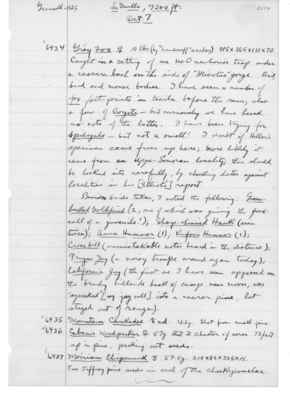Pages That Mention Gray Fox
1925: Joseph Grinnell's field notes
S3 Page 31
Collector: Grinnell - 1925 Location: La Grulla, 7200 ft. Date: Oct. 7 Page Number: 2574
6434 Gray Fox (female sign) 10 lbs. (by "handcuff" scales). 915x365x121x70. Caught in a setting of one no. 0 newhouse trap under a cascara bush on the side of "Microtus" gorge. Bait, bird and mouse bodies. I have seen a number of fox foot-prints in trails before the rain; also a few of Coyote -- but curiously we have heard no note of the latter. I have been trying for Spilogale -- but not a smell! I doubt if Heller's specimen came from up here; more likely it came from an upper Sonoran locality; this should be looked into carefully, by checking dates against localities in his [Elliot's] report. Besides birds taken, I noted the following: Green backed Goldfinch(2, one of which was giving the food call of a juvenile; Sharp-shinned Hawk (seen twice); Anna Hummer (1); Rufous Hummer (1); Crossbill (unmistakable notes heard in the distance); Pinyon Jay (a noisy troupe around again today); California Jay (the first one I have seen appeared on the brushy hillside back of camp near noon, was "squeaked" [my jay call] into a nearer pine, but stayed out of range). 6435 Mountain Chickadee (male sign) ad. 12.2g. Shot from small pine. 6436 Cabanis Woodpecker (female sign) 57g. Shot at cluster of cones 75 feet up in pine, pecking out seeds. 6437 Merriam Chipmunk (male sign) 57.5g. 215x86x32.5x15. Two Jeffrey pine seeds in each of the cheek-pouches.
S3 Page 34
Collector: Grinnell - 1925 Location: La Grulla, 7200 ft. Date: Oct. 8 Page Number: 2577
reported up to 35, in a bunch, frequently seen in the San Felipe desert, just east of here -- 15 miles away. No antelope west of here, north of between Santa Catarina and Punta Puerta, where there is a desert country. Spotted Skunks are common on the desert side of the mountains; also westward, reported, but not seen personally by Mr. Melling (sic). Besides the ordinary Gray Fox, there is a Kit Fox, caught down on the desert east of Diablo. Condors are getting scarce. When cattle die (of blackleg often) during the summer, condors come in from the east (desert) side to feed on the carcasses, 1 to as many as 7 or 8 at one carcass. No one bothers the condors. Mr. Meling has seen none this year; only 4 last year. No one ever comes here to trap for fur. 7 p.m. - Barometer, 23.10; warmer; mare's-tails overhead. Oct 9. Results of trapping: Peromyscus truei, (male sign) and (female sign), in upland situations alongside or under edges of boulders near cascara bushes; discarded. 6452 Eutamias merriami (male sign) 56.7g. 222x93x33.5x16. In rat-trap under edge of boulder. 6453 Eutamias merriami (male sign) 60.0g. 220x94x34x16. In rat-trap under edge of manzanita thicket. 6454 House Wren (male sign) ad. 11.1g. Shot under buckthorn bush. Looks big; compare with northern breeding birds. 6455 Pigmy Nuthatch (female sign) ad. 10.9g. Shot from pine.

